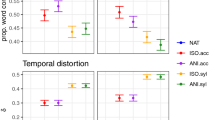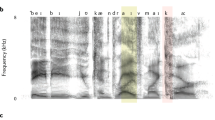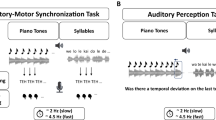Abstract
Evidence suggests that temporal predictions arising from the motor system can enhance auditory perception. However, in speech perception, we lack evidence of perception being modulated by production. Here we show a behavioural protocol that captures the existence of such auditory–motor interactions. Participants performed a syllable discrimination task immediately after producing periodic syllable sequences. Two speech rates were explored: a ‘natural’ (individually preferred) and a fixed ‘non-natural’ (2 Hz) rate. Using a decoding approach, we show that perceptual performance is modulated by the stimulus phase determined by a participant’s own motor rhythm. Remarkably, for ‘natural’ and ‘non-natural’ rates, this finding is restricted to a subgroup of the population with quantifiable auditory–motor coupling. The observed pattern is compatible with a neural model assuming a bidirectional interaction of auditory and speech motor cortices. Crucially, the model matches the experimental results only if it incorporates individual differences in the strength of the auditory–motor connection.
This is a preview of subscription content, access via your institution
Access options
Access Nature and 54 other Nature Portfolio journals
Get Nature+, our best-value online-access subscription
$29.99 / 30 days
cancel any time
Subscribe to this journal
Receive 12 digital issues and online access to articles
$119.00 per year
only $9.92 per issue
Buy this article
- Purchase on Springer Link
- Instant access to full article PDF
Prices may be subject to local taxes which are calculated during checkout





Similar content being viewed by others
Data availability
The data that support this study are available from the corresponding authors upon request.
Code availability
Custom code that supports the findings of this study is available from the corresponding authors upon request.
References
Coull, J. T. A in Brain Mapping (ed. Toga, A. W.) 565–570 (Academic Press, 2015).
Merchant, H. & Yarrow, K. How the motor system both encodes and influences our sense of time. Time Percept. Action 8, 22–27 (2016).
Morillon, B. & Baillet, S. Motor origin of temporal predictions in auditory attention. Proc. Natl Acad. Sci. USA 114, E8913 (2017).
Morillon, B., Schroeder, C. E. & Wyart, V. Motor contributions to the temporal precision of auditory attention. Nat. Commun. 5, 5255 (2014).
Schroeder, C. E., Wilson, D. A., Radman, T., Scharfman, H. & Lakatos, P. Dynamics of active sensing and perceptual selection. Cogn. Neurosci. 20, 172–176 (2010).
Morillon, B., Hackett, T. A., Kajikawa, Y. & Schroeder, C. E. Predictive motor control of sensory dynamics in auditory active sensing. Curr. Opin. Neurobiol. 31, 230–238 (2015).
Davis, M. H. & Johnsrude, I. S. Hierarchical processing in spoken language comprehension. J. Neurosci. 23, 3423–3431 (2003).
Devlin, J. T. & Aydelott, J. Speech perception: motoric contributions versus the motor theory. Curr. Biol. 19, R198–R200 (2009).
Scott, S. K., McGettigan, C. & Eisner, F. A little more conversation, a little less action–candidate roles for the motor cortex in speech perception. Nat. Rev. Neurosci. 10, 295–302 (2009).
Wild, C. J. et al. Effortful listening: the processing of degraded speech depends critically on attention. J. Neurosci. 32, 14010–14021 (2012).
Chen, J. L., Penhune, V. B. & Zatorre, R. J. Listening to musical rhythms recruits motor regions of the brain. Cereb. Cortex 18, 2844–2854 (2008).
Fujioka, T., Trainor, L. J., Large, E. W. & Ross, B. Internalized timing of isochronous sounds is represented in neuromagnetic beta oscillations. J. Neurosci. 32, 1791–1802 (2012).
Grahn, J. A. & Rowe, J. B. Feeling the beat: premotor and striatal interactions in musicians and nonmusicians during beat perception. J. Neurosci. 29, 7540–7548 (2009).
Besle, J. et al. Tuning of the human neocortex to the temporal dynamics of attended events. J. Neurosci. 31, 3176–3185 (2011).
Lakatos, P. et al. An oscillatory hierarchy controlling neuronal excitability and stimulus processing in the auditory cortex. J. Neurophysiol. 94, 1904–1911 (2005).
Giraud, A.-L. & Poeppel, D. Cortical oscillations and speech processing: emerging computational principles and operations. Nat. Neurosci. 15, 511–517 (2012).
Large, E. W. & Jones, M. R. The dynamics of attending: how people track time-varying events. Psychol. Rev. 106, 119–159 (1999).
Rimmele, J. M., Morillon, B., Poeppel, D. & Arnal, L. H. Proactive sensing of periodic and aperiodic auditory patterns. Trends Cogn. Sci. 22, 870–882 (2018).
Haegens, S. & Zion Golumbic, E. Rhythmic facilitation of sensory processing: a critical review. Neurosci. Biobehav. Rev. https://doi.org/10.1016/j.neubiorev.2017.12.002 (2017).
Tian, X. & Poeppel, D. Dynamics of self-monitoring and error detection in speech production: evidence from mental imagery and MEG. J. Cogn. Neurosci. 27, 352–364 (2015).
Ding, N. et al. Temporal modulations in speech and music. Neurosci. Biobehav. Rev. https://doi.org/10.1016/j.neubiorev.2017.02.011 (2017).
Coupé, C., Oh, Y. M., Dediu, D. & Pellegrino, F. Different languages, similar encoding efficiency: comparable information rates across the human communicative niche. Sci. Adv. 5, eaaw2594 (2019).
Morillon, B., Arnal, L. H., Schroeder, C. E. & Keitel, A. Prominence of delta oscillatory rhythms in the motor cortex and their relevance for auditory and speech perception. Neurosci. Biobehav. Rev. 107, 136–142 (2019).
Keitel, A., Gross, J. & Kayser, C. Perceptually relevant speech tracking in auditory and motor cortex reflects distinct linguistic features. PLOS Biol. 16, e2004473 (2018).
Park, H., Ince, R. A. A., Schyns, P. G., Thut, G. & Gross, J. Frontal top-down signals increase coupling of auditory low-frequency oscillations to continuous speech in human listeners. Curr. Biol. 25, 1649–1653 (2015).
Cason, N., Astesano, C. & Schon, D. Bridging music and speech rhythm: rhythmic priming and audio–motor training affect speech perception. Acta Psychol. (Amst.) 155, 43–50 (2015).
Cason, N. & Schon, D. Rhythmic priming enhances the phonological processing of speech. Neuropsychologia 50, 2652–2658 (2012).
Falk, S., Lanzilotti, C. & Schon, D. Tuning neural phase entrainment to speech. J. Cogn. Neurosci. 29, 1378–1389 (2017).
Hickok, G., Farahbod, H. & Saberi, K. The rhythm of perception: entrainment to acoustic rhythms induces subsequent perceptual oscillation. Psychol. Sci. 26, 1006–1013 (2015).
Kösem, A., Basirat, A., Azizi, L. & van Wassenhove, V. High-frequency neural activity predicts word parsing in ambiguous speech streams. J. Neurophysiol. 116, 2497 (2016).
Sanabria, D. & Correa, Á. Electrophysiological evidence of temporal preparation driven by rhythms in audition. Biol. Psychol. 92, 98–105 (2013).
McPherson, T., Berger, D., Alagapan, S. & Fröhlich, F. Intrinsic rhythmicity predicts synchronization–continuation entrainment performance. Sci. Rep. 8, 11782 (2018).
Assaneo, M. F. et al. Spontaneous synchronization to speech reveals neural mechanisms facilitating language learning. Nat. Neurosci. 22, 627–632 (2019).
Park, H., Thut, G. & Gross, J. Predictive entrainment of natural speech through two fronto-motor top-down channels. Lang. Cogn. Neurosci. 35, 739–751 (2018).
Zalta, A., Petkoski, S. & Morillon, B. Natural rhythms of periodic temporal attention. Nat. Commun. 11, 1051 (2020).
Assaneo, M. F. & Poeppel, D. The coupling between auditory and motor cortices is rate-restricted: evidence for an intrinsic speech-motor rhythm. Sci. Adv. 4, eaao3842 (2018).
Schönbrodt, F. D. & Wagenmakers, E.-J. Bayes factor design analysis: planning for compelling evidence. Psychon. Bull. Rev. 25, 128–142 (2018).
Nobre, A. C., Correa, A. & Coull, J. T. The hazards of time. Sens. Syst. 17, 465–470 (2007).
Thomas, E. A. C. Reaction-time studies: the anticipation and interaction of responses. Br. J. Math. Stat. Psychol. 20, 1–29 (1967).
Grabenhorst, M., Michalareas, G., Maloney, L. T. & Poeppel, D. The anticipation of events in time. Nat. Commun. 10, 5802 (2019).
Yeung, M. K. S. & Strogatz, S. H. Time delay in the kuramoto model of coupled oscillators. Phys. Rev. Lett. 82, 648–651 (1999).
Poeppel, D. & Assaneo, M. F. Speech rhythms and their neural foundations. Nat. Rev. Neurosci. https://doi.org/10.1038/s41583-020-0304-4 (2020).
Doelling, K. B., Assaneo, M. F., Bevilacqua, D., Pesaran, B. & Poeppel, D. An oscillator model better predicts cortical entrainment to music. Proc. Natl Acad. Sci. USA 116, 10113 (2019).
Ruspantini, I. et al. Corticomuscular coherence is tuned to the spontaneous rhythmicity of speech at 2–3 Hz. J. Neurosci. 32, 3786 (2012).
Hansen, P., Kringelbach, M., & Salmelin, R. (eds.). MEG: an Introduction to Methods (Oxford Univ. Press, 2010).
Tian, X. & Poeppel, D. The effect of imagination on stimulation: the functional specificity of efference copies in speech processing. J. Cogn. Neurosci. 25, 1020–1036 (2013).
Timm, J., Schönwiesner, M., Schröger, E. & SanMiguel, I. Sensory suppression of brain responses to self-generated sounds is observed with and without the perception of agency. Cortex 80, 5–20 (2016).
Cao, L., Thut, G. & Gross, J. The role of brain oscillations in predicting self-generated sounds. NeuroImage 147, 895–903 (2017).
Lakatos, P., Gross, J. & Thut, G. A new unifying account of the roles of neuronal entrainment. Curr. Biol. 29, R890–R905 (2019).
Chang, E. F., Niziolek, C. A., Knight, R. T., Nagarajan, S. S. & Houde, J. F. Human cortical sensorimotor network underlying feedback control of vocal pitch. Proc. Natl Acad. Sci. USA 110, 2653 (2013).
Riecke, L., Formisano, E., Sorger, B., Baskent, D. & Gaudrain, E. Neural entrainment to speech modulates speech intelligibility. Curr. Biol. https://doi.org/10.1016/j.cub.2017.11.033 (2017).
Riecke, L., Formisano, E., Herrmann, C. S. & Sack, A. T. 4-Hz transcranial alternating current stimulation phase modulates hearing. Brain Stimulat. 8, 777–783 (2015).
Henry, M. J. & Obleser, J. Frequency modulation entrains slow neural oscillations and optimizes human listening behavior. Proc. Natl Acad. Sci. USA 109, 20095 (2012).
Stefanics, G. et al. Phase entrainment of human delta oscillations can mediate the effects of expectation on reaction speed. J. Neurosci. 30, 13578–13585 (2010).
Riecke, L., Sack, A. T. & Schroeder, C. E. Endogenous delta/theta sound-brain phase entrainment accelerates the buildup of auditory streaming. Curr. Biol. 25, 3196–3201 (2015).
Zoefel, B., Davis, M. H., Valente, G. & Riecke, L. How to test for phasic modulation of neural and behavioural responses. NeuroImage 202, 116175 (2019).
Repp, B. H. & Penel, A. Rhythmic movement is attracted more strongly to auditory than to visual rhythms. Psychol. Res. 68, 252–270 (2004).
Brainard, D. H. The psychophysics toolbox. Spat. Vis. 10, 433–436 (1997).
Boersma, P. Praat, a system for doing phonetics by computer. Glot Int. 5, 341–345 (2001).
Kontsevich, L. L. & Tyler, C. W. Bayesian adaptive estimation of psychometric slope and threshold. Vision Res. 39, 2729–2737 (1999).
Chi, T., Ru, P. & Shamma, S. A. Multiresolution spectrotemporal analysis of complex sounds. J. Acoust. Soc. Am. 118, 887–906 (2005).
NSL MATLAB Toolbox (Neural Systems Laboratory, University of Maryland, 2003).
Moskowitz, C. S. & Pepe, M. S. Quantifying and comparing the predictive accuracy of continuous prognostic factors for binary outcomes. Biostat. Oxf. Engl. 5, 113–127 (2004).
Huang, Y., Sullivan Pepe, M. & Feng, Z. Evaluating the predictiveness of a continuous marker. Biometrics 63, 1181–1188 (2007).
JASP version 0.12 (JASP Team, 2020).
Lee, M. D. & Wagenmakers, E.-J. Bayesian Cognitive Modeling: A Practical Course pp. xiii, 264 (Cambridge Univ. Press, 2013).
Cabral, J. et al. Exploring mechanisms of spontaneous functional connectivity in MEG: how delayed network interactions lead to structured amplitude envelopes of band-pass filtered oscillations. NeuroImage 90, 423–435 (2014).
Guenther, F. H., Ghosh, S. S. & Tourville, J. A. Neural modeling and imaging of the cortical interactions underlying syllable production. Brain Lang. 96, 280–301 (2006).
Acknowledgements
We thank M. Grabenhorst, J.-R. King and L. Gwilliams for their valuable input regarding the data analysis, M. Fichter for data recordings and S. Brendecke for graphics support. This work was funded by the Max-Planck-Institute for Empirical Aesthetics. The funders had no role in the conceptualization, design, data collection, analysis, decision to publish, or preparation of the manuscript.
Author information
Authors and Affiliations
Contributions
M.F.A., J.M.R. and D.P. conceived of and designed the experiments. J.M.R. collected the data. M.F.A. and J.M.R. conceived and designed the analyses. M.F.A. performed the main analyses and contributed the SSS-test analysis toolbox. Y.S.P. and M.F.A. generated the computational model. M.F.A., J.M.R. and D.P. interpreted the results. M.F.A. and J.M.R. wrote the manuscript. All authors edited the manuscript.
Corresponding authors
Ethics declarations
Competing interests
The authors declare no competing interests.
Additional information
Peer review information Primary Handling Editor: Marike Schiffer.
Publisher’s note Springer Nature remains neutral with regard to jurisdictional claims in published maps and institutional affiliations.
Supplementary information
Rights and permissions
About this article
Cite this article
Assaneo, M.F., Rimmele, J.M., Sanz Perl, Y. et al. Speaking rhythmically can shape hearing. Nat Hum Behav 5, 71–82 (2021). https://doi.org/10.1038/s41562-020-00962-0
Received:
Accepted:
Published:
Issue Date:
DOI: https://doi.org/10.1038/s41562-020-00962-0
This article is cited by
-
Auditory-motor synchronization and perception suggest partially distinct time scales in speech and music
Communications Psychology (2024)
-
Replication of population-level differences in auditory-motor synchronization ability in a Norwegian-speaking population
Communications Psychology (2023)
-
Auditory-motor synchronization varies among individuals and is critically shaped by acoustic features
Communications Biology (2023)
-
Delta/Theta band EEG activity shapes the rhythmic perceptual sampling of auditory scenes
Scientific Reports (2021)



